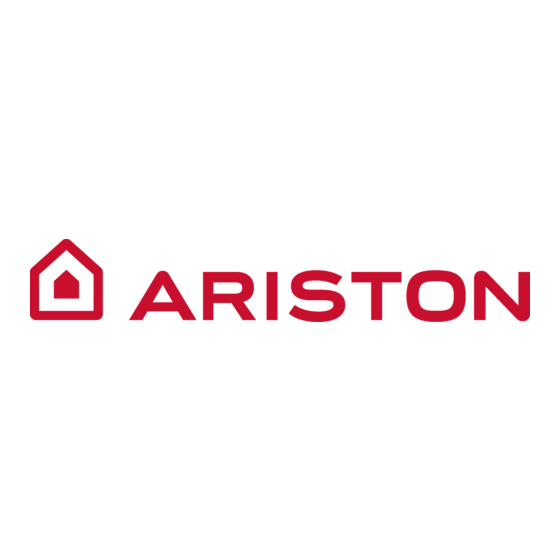Ariston GENUS PREMIUM EVO 30 Instrukcje instalacji i serwisowania - Strona 45
Przeglądaj online lub pobierz pdf Instrukcje instalacji i serwisowania dla Kocioł Ariston GENUS PREMIUM EVO 30. Ariston GENUS PREMIUM EVO 30 48 stron. Condensing wall-hung gas boiler
Również dla Ariston GENUS PREMIUM EVO 30: Podręcznik użytkownika (17 strony), Podręcznik użytkownika (12 strony), Podręcznik użytkownika (12 strony)

La manutenzione è essenziale per la sicurezza, il buon funzionamento
e la durata della caldaia. Va eff ettuata in base a quanto previsto dalle
norme vigenti. E' consigliabile eseguire periodicamente l'analisi della
combustione per controllare il rendimento e le emissioni inquinanti
della caldaia, secondo le norme vigenti.
Prima di iniziare le operazioni di manutenzione:
- togliere l'alimentazione elettrica posizionando l'interruttore
bipolare esterno alla caldaia in posizione OFF;
- chiudere il rubinetto del gas e dell'acqua degli impianti termici e
sanitari.
Al termine vanno ripristinate le regolazioni iniziali.
Note Generali
Si raccomanda di eff ettuare sull'apparecchio, almeno una volta
l'anno, i seguenti controlli:
1. Controllo delle tenute della parte acqua con eventuale sostituzione
delle guarnizioni e ripristino della tenuta.
2. Controllo delle tenute della parte gas con eventuale sostituzione
delle guarnizioni e ripristino della tenuta.
3. Controllo visivo dello stato complessivo dell'apparecchio.
4. Controllo visivo della combustione ed eventuale smontaggio e
pulizia del bruciatore
5. A seguito del controllo al punto "3", eventuale smontaggio e
pulizia della camera di combustione.
6. A seguito del controllo al punto "4", eventuale smontaggio e
pulizia del bruciatore e dell'iniettore.
7. Pulizia dello scambiatore di calore primario.
8. Verifi ca del funzionamento dei sistemi di sicurezza riscaldamento:
- sicurezza temperatura limite.
9. Verifi ca del funzionamento dei sistemi di sicurezza parte gas:
- sicurezza mancanza gas o fi amma (ionizzazione).
10.Controllo dell'effi cienza della produzione di acqua sanitaria
(verifi ca della portata e della temperatura).
11.Controllo generale del funzionamento dell'apparecchio.
12.Rimozione dell'ossido dall'elettrodo di rilevazione tramite tela
smeriglio.
Pulizia dello scambiatore primario
PULIZIA LATO FUMI
Si accede all'interno dello scambiatore primario smontando il brucia-
tore. Il lavaggio può essere eff ettuato con acqua e detergente, aiutan-
dosi con un pennello non metallico, risciacquare con acqua.
Pulizia sifone
Si accede al sifone svitando in senso arario il bicchiere raccolta
condensa, situato nella parte inferiore destra. Il lavaggio può essere
effettuato con acqua e detergente.
Rimontare il bicchiere raccolta condensa nel suo alloggio.
NB. in caso di prolungato inutilizzo dell'apparecchio il sifone va
riempito prima di una nuova accensione.
Il mancato reintegro dell'acqua nel sifone è pericoloso in quanto
c'è possibilità di uscita di fumi nell'ambiente.
Prova di funzionamento
Dopo aver eff ettuato le operazioni di manutenzione, riempire il
circuito di riscaldamento alla pressione di circa 1,0 bar e sfi atare
l'impianto.
Riempire anche l'impianto sanitario.
- Mettere in funzione l'apparecchio.
- Se è necessario sfi atare nuovamente l'impianto di riscaldamento.
- Verifi care le impostazioni e il buon funzionamento di tutti gli
organi di comando, regolazione e controllo.
- Verifi care la tenuta e il buon funzionamento dell'impianto di
evecuazione fumi/prelievo aria comburente.
manutenzione
Maintenance is an essential part of the safe and effi cient operation of
the boiler and ensures its durability. It should be performed according
to the instructions given in current legislation. Perform combustion
analysis regularly in order to check the operating effi ciency of the
boiler and to make sure any polluting substances released are within
the boudaries set by current legislation.
Before beginning maintenance work:
-
-
After the work has been completed the initial settings will be restored.
General comments
It is recommended that the following inspections be carried out on
the boiler at least once a year:
1.
2.
3.
4.
5.
6.
7.
8.
9.
10. Check the effi ciency of the domestic hot water production
11. Perform a general inspection of the boiler operation.
12. Remove oxide from the detection electrode using an emery
Cleaning the primary exchanger
Cleaning the smoke side
The inside of the primary exchanger is accessed by removing the
burner. Wash with water and detergent using a non-metallic rifl e-
type brush, rinse with water.
Cleaning the trap
The trap is accessed by emptying the condensate bowl located in
the bottom section. Wash with water and detergent.
Replace the condensate collection bowl in its housing.
NB: In the event of prolonged use of the appliance, the trap
must be fi lled before being used again.
A lack of water in the trap is dangerous and may cause smoke to
be released into the atmosphere
Operational test
After having carried out the maintenance operations, fi ll the heating
circuit at a pressure of approximately 1.5 bar and release the air from
the system.
Fill the domestic hot water system at the same time.
- Begin operating the boiler.
- If necessary, release the air from the heating system again.
- Check the settings and make sure all the command, adjustment
and monitoring parts are working correctly.
- Check the fl ue system is sealed and operating correctly.
Disconnect the appliance from the electricity supply by turning
the external bipolar switch to the "OFF" position;
Close the gas valve and the central heating and domestic hot
water system valves.
Check the seals in the water part and, if necessary, replace the
gaskets and restore the seal to perfect working order.
Check the seals in the gas part and, if necessary, replace the
gaskets and restore the seal to perfect working order.
Visually check the overall condition of the boiler.
Visually check the combustion and, if necessary, disassemble
and clean the burner.
Following the inspection detailed in point "3", disassemble and
clean the combustion chamber, if necessary.
Following the inspection detailed in point "4", disassemble and
clean the burner and injector, if necessary.
Cleaning the primary heat exchanger
Make sure the following heating safety devices are operating
correctly:
- temperature limit safety device.
Make sure that the following gas part safety devices are
operating correctly:
- absence of gas or fl ame safety device (ionisation).
process (test the fl ow rate and temperature).
cloth.
maintenance
45
